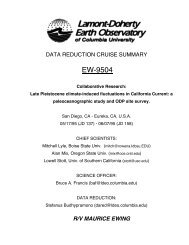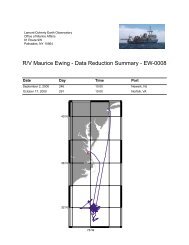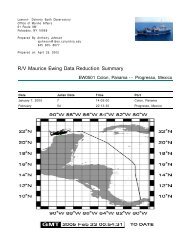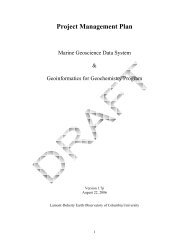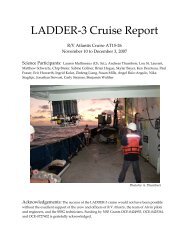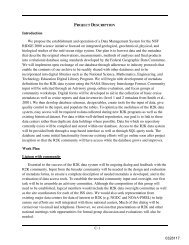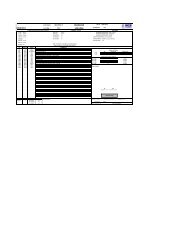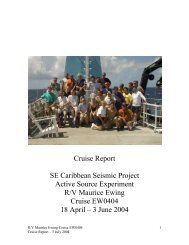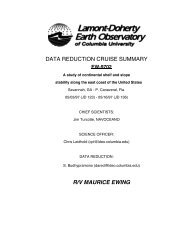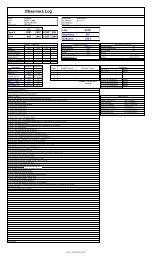Infrared was less useful because of low variability in surface temperature in summer.This was supplemented by imagery provided through the European Polarview program. This is a multinationalprogram designed to provide a variety of products to ships operating in ice-covered waters. Severalnational Antarctic programs use a variety of data routinely aboard ships where large-bandwidth data transmissionis available.AMSR-E, Quikscat POL, and reduced resolution ENVISAT ASAR 3-day composites were provided byRoberto Saldo at Denmark Technical University. Pre-arranged acquisition of wide swath ASAR was facilitatedby Andrew Fleming at BAS, who sent high resolution sub-images upon request to the NBP. ASARimagery proved extremely helpful in identifying areas of both pack and fast ice suitable for deploymentof instrumentation. It was indispensible in finding fast ice in the Western Pine Island Bay, and aided inlocating a fast ice site for one of the BAS IMBs and the ITP/IMB site. However, it was severely limitedwhen the ship was operating outside of INMARSAT range. File size restrictions on email - even on specialaccounts - severely limited image quality. It would be worth pursuing having a separate system for stagingimagery to be sent via Iridium. It is also worth implementing a means for downloading imagery over theweb via Iridium. This has been done successfully on other ships. The advantage is that imagery can bebrowsed at low resolution at the Antarctic Polarview node website, and subregions may be downloaded athigh resolution.Visible OLS was useful when weather was clear, which occurred several times during the cruise. Quikscatwas of little use. It often is useful in delineating the full extent of sea ice, but it seemed to consistentlyoverestimate ice extent.Perhaps the most used sources of imagery were passive microwave from SSM/I or AMSR-E. Qualitatively,both did a fairly good job at detecting sea ice extent, with errors usually smaller than expected for this timeof year. There are some caveats regarding its use for navigational purposes, however:The Terrascan system onboard provided ice extent using a number of algorithms, with often quite differentresults. Some of these appear to use a 15% cutoff as implemented on the NBP (such as the Artist algorithm),while others do not (such as SeaLion and Bootstrap). Some of the Algorithms provide a higher resolutionproduct (SeaLion and Artist), but do so by using the 89 GHz Channel. This is much more subject toweather effects than the other channels and so can produce large errors in ice concentration. While thebootstrap product is lower resolution, it appeared to be less affected by spurious day-to-day variations in iceconcentration. This can be confusing to those less familiar with this type of data.During <strong>NBP09</strong><strong>01</strong>, satellite ice concentration varied considerably in the pack ice north of the coastal polynyasduring late January - early February. This is likely due to surface emissivity variations associated with meltfreezecycles and weather. Again, the Bootstrap algorithm performed better at the cost of lower resolution.There appear to be issues with the F15 satellite. This showed very little ice compared to others on manyoccasions.AMSR-E provides a more reliable ice concentration than the SSM/I products at equivalent resolution(SeaLion and Artist), but is still subject to some of the same problems with surface emissivity variation.However, as this is not available via Terrascan, it was often 1-2 days late.5.6 ReferencesHaas, C., D.N. Thomas and J. Bareiss (20<strong>01</strong>), Surface properties an processes of perennial Antarctic sea icein summer, J. Glaciology, 47, 613-25Worby, A.P. and I. Allison (1999), A technique for making ship-based observations of Antarctic sea icethickness and characteristics. Part I. Observational techniques and results. Antarct. CRC Res. Rep. 14,1-23.<strong>NBP09</strong>-<strong>01</strong> <strong>Cruise</strong> <strong>Report</strong> (p. 42 of 83) Revised February 27, 2009
6 Seafloor MappingFrank Nitsche, Kathleen Gavahan6.1 ObjectiveA large portion of the bathymetry of the continental margin around Antarctica is still unmapped. In theAmundsen Sea, scientific questions concerning warm water entering the shelf and collecting in deep innershelf troughs depend on the local and regional bathymetry. Detailed bathymetry data were also neededto determine depth and location of CTD and mooring sites as well as for planning Autosub operations.Improving the existing bathymetry of the Amundsen Sea continental shelf also better defines existing troughsand supports reconstruction of past ice flow on the continental shelf.We have thus been running the swath-mapping system throughout <strong>NBP09</strong><strong>01</strong> The main mapping teamconsisted of Kathleen Gavahan (Raytheon) and Frank Nitsche (LDEO) and was supported by several others,especially Ken Mankoff, Adrian Jenkins, Robin Robertson, Chris Little, Stan Jacobs, Andy Webb, PierreDutrieux, and Sharon Stammerjohn, who helped edit raw multibeam files.6.2 System Description and OperationThe main equipment used for seafloor mapping on this cruise was the Simrad EM-120 swath-mapping system.It operates at a 12 kHz main frequency and receives up to 191 beams from angles up to 65 o to each sideof the ship, providing a resolution of ∼1.5 o of the seafloor and a coverage of ∼4 times the water depth.To adjust for changes in sound velocity, CTD and XBT data were used to update to the local conditionsthroughout the cruise.The raw data are recorded digitally and displayed in real-time. Once a day the raw data were processed andedited manually for outliers and false bottom returns using the mb-system 5 software package. The finaldata are stored in MBsystem format 57 and will be archived at the Antarctic Multibeam Synthesis <strong>Data</strong>base(http://www.marine-geo.org/antarctic/).In addition to the swath-mapping system we almost continuously ran a sub-bottom profiler to provideindependent depth measurements. Sub-bottom data can also be used to determine sediment sample locations.At the start of the cruise a Knudsen 320B echosounder with 3.5 kHz main operating frequency was used.From January 16th 2009 we used the Ocean <strong>Data</strong> Equipment Corporation Bathy 2000 echosounder andsub-bottom profiler. The Bathy 2000 transmits a chirp signal of 3.5 to 4 kHz. It determines the bottomand images the uppermost subbottom sediment layers down to a few 10s of meters depending on sedimentcharacter. The data were archived digitally in the Bathy2000 variant of the SEGY-format.Additional bathymetry data of previous NB Palmer , JC Ross, Polarstern, and Oden cruises provided extraguidance and helped to avoid accidental duplication of existing tracks.6.3 System Performance and ProblemsThroughout the cruise, both the EM-120 swath-bathymetry and the Bathy2000 echosounder operated normallyunder most conditions, but had problems with receiving good data in sea ice. The Bathy2000 wasonly disturbed by heavy pack ice but the EM-120 multibeam had problems with heavy pack ice and certaintypes of newly formed ice such as grease ice and nilas. The ice gets under the ship, blocking signals comingto and from the transducers, producing bad data even in easy and calm conditions. We rarely encounteredsuch ice conditions during <strong>NBP09</strong><strong>01</strong>, but a larger issue was the drastic drop in data quality in rough seas.<strong>NBP09</strong>-<strong>01</strong> <strong>Cruise</strong> <strong>Report</strong> (p. 43 of 83) Revised February 27, 2009
- Page 3 and 4: List of Figures1 Regional map of CT
- Page 5 and 6: Universities and to Raytheon Polar
- Page 8 and 9: 1, 7, 104, and 159. At least one ad
- Page 10 and 11: and dissolved oxygen decreasing wit
- Page 12: Primary-Secondary O2 sensor differe
- Page 15 and 16: Run Test 1 2 3 4 5 6 7 8 9 10 11Stb
- Page 17 and 18: In order to estimate the accuracy o
- Page 19 and 20: ice-ocean boundary layer. To do thi
- Page 21 and 22: Figure 17: Using small boat for rec
- Page 23 and 24: Figure 19: Planned mission profiles
- Page 25 and 26: was under way (Figure 17). This met
- Page 27 and 28: # Starttime, pos,duration, km427428
- Page 29 and 30: S. Jacobs O-274-N Mooring Schematic
- Page 31 and 32: at the helm.The high iceberg produc
- Page 33 and 34: Seasonal sea ice changes in the Amu
- Page 35 and 36: in the Amundsen Sea - (1) the confi
- Page 37 and 38: An automated camera system provided
- Page 39 and 40: presence of ice layers and wicked b
- Page 41: enough number to be able to regiona
- Page 45 and 46: Due to the location of the transduc
- Page 47 and 48: Figure 29: Water column thickness (
- Page 49 and 50: Figure 31: A south-to-north cross s
- Page 51 and 52: phytoplankton from the upper 200m w
- Page 53 and 54: uptake (K m ) as well as the maximu
- Page 55 and 56: Elmer UV/VIS Lambda 18 spectrophoto
- Page 57 and 58: Figure 37: Section plot of dissolve
- Page 59 and 60: ligand ’TAC’ (2-(2-Thiazolylazo
- Page 61 and 62: Both GA and PA, at times, resulted
- Page 63 and 64: 9 Other Sampling and Profiling9.1 O
- Page 65 and 66: Figure 42: XBTs gridded as if they
- Page 67 and 68: on them. A single hollow column is
- Page 69 and 70: in ways that are accessible to a wi
- Page 71 and 72: AppendicesACruise ParticipantsPerso
- Page 73 and 74: BCTD Station TableNo. Date Time Lat
- Page 75 and 76: continued from previous pageNo. Dat
- Page 77 and 78: CPre-cruise Project PlansC.1 Amunds
- Page 79 and 80: Figure 48: Missions, three each, pe
- Page 81 and 82: C.4 Collaborative Research: Samplin



